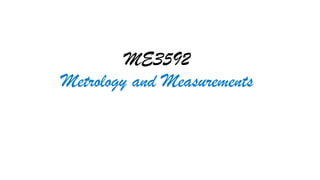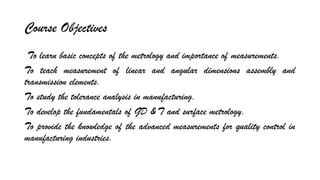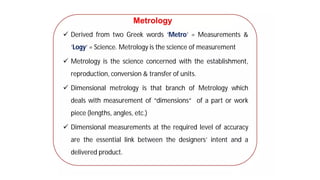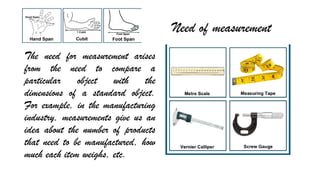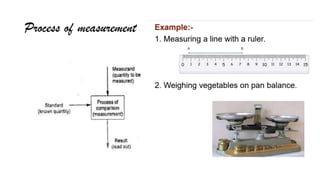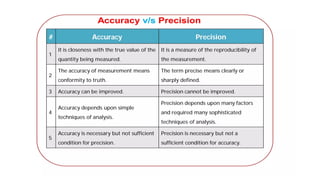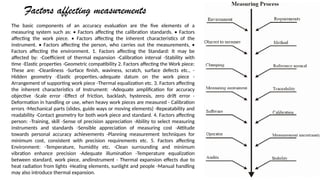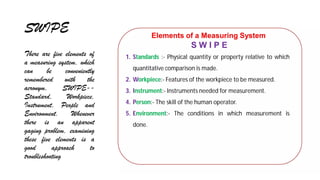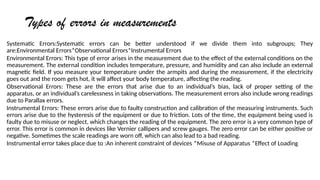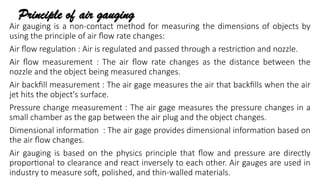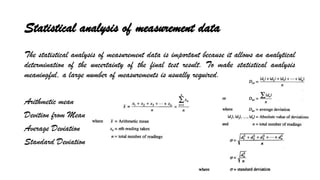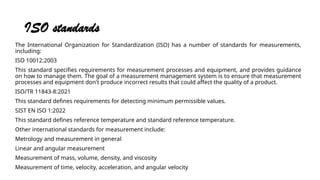ME3592 Metrology and Measurements Unit I
- 2. Course Objectives To learn basic concepts of the metrology and importance of measurements. To teach measurement of linear and angular dimensions assembly and transmission elements. To study the tolerance analysis in manufacturing. To develop the fundamentals of GD & T and surface metrology. To provide the knowledge of the advanced measurements for quality control in manufacturing industries.
- 3. UNIT ¨C I BASICS OF METROLOGY Measurement ¨C Need, Process, Role in quality control; Factors affecting measurement - SWIPE; Errors in Measurements ¨C Types ¨C Control ¨C Measurement uncertainty ¨C Types, Estimation, Problems on Estimation of Uncertainty, Statistical analysis of measurement data, Measurement system analysis, Calibration of measuring instruments, Principle of air gauging- ISO standards
- 5. Need of measurement The need for measurement arises from the need to compare a particular object with the dimensions of a standard object. For example, in the manufacturing industry, measurements give us an idea about the number of products that need to be manufactured, how much each item weighs, etc.
- 10. Role in Quality Control Measurement and process control are important for quality control in manufacturing and other industries because they help ensure consistency, optimize production, and maintain product quality: Measurement : Measurement is used to establish which data to collect, and then to determine the tools and techniques to use to measure that data. For example, a smartphone manufacturer might measure defects in production, and then use tools to assess each production run. Process control : Process control involves monitoring and regulating the processes involved in manufacturing a product. This is done using various instruments and techniques. Quality control measurements : Quality control measurements are documented results that are captured in formats specified by the Plan Quality Management process. These measurements can be used to generate change requests, project document updates, and other updates to ensure quality standards are met. Statistical sampling : Statistical sampling involves measuring a portion of all products, and then making inferences about the remainder of the products based on that sample
- 11. Factors affecting measurements The basic components of an accuracy evaluation are the five elements of a measuring system such as: ? Factors affecting the calibration standards. ? Factors affecting the work piece. ? Factors affecting the inherent characteristics of the instrument. ? Factors affecting the person, who carries out the measurements, ? Factors affecting the environment. 1. Factors affecting the Standard: It may be affected by: -Coefficient of thermal expansion -Calibration interval -Stability with time -Elastic properties -Geometric compatibility 2. Factors affecting the Work piece: These are: -Cleanliness -Surface finish, waviness, scratch, surface defects etc., - Hidden geometry -Elastic properties,-adequate datum on the work piece - Arrangement of supporting work piece -Thermal equalization etc. 3. Factors affecting the inherent characteristics of Instrument: -Adequate amplification for accuracy objective -Scale error -Effect of friction, backlash, hysteresis, zero drift error - Deformation in handling or use, when heavy work pieces are measured - Calibration errors -Mechanical parts (slides, guide ways or moving elements) -Repeatability and readability -Contact geometry for both work piece and standard. 4. Factors affecting person: -Training, skill -Sense of precision appreciation -Ability to select measuring instruments and standards -Sensible appreciation of measuring cost -Attitude towards personal accuracy achievements -Planning measurement techniques for minimum cost, consistent with precision requirements etc. 5. Factors affecting Environment: -Temperature, humidity etc. -Clean surrounding and minimum vibration enhance precision -Adequate illumination -Temperature equalization between standard, work piece, andinstrument - Thermal expansion effects due to heat radiation from lights -Heating elements, sunlight and people -Manual handling may also introduce thermal expansion.
- 12. SWIPE There are five elements of a measuring system, which can be conveniently remembered with the acronym, SWIPE-- Standard, Workpiece, Instrument, People and Environment. Whenever there is an apparent gaging problem, examining these five elements is a good approach to troubleshooting
- 13. Errors in measurements There are three types of errors that are classified based on the source they arise from; They are: Gross Errors*Random Errors*Systematic Errors Gross Errors:This category basically takes into account human oversight and other mistakes while reading, recording, and readings. The most common human error in measurement falls under this category of measurement errors. For example, the person taking the reading from the meter of the instrument may read 23 as 28. Gross errors can be avoided by using two suitable measures, and they are written below: Proper care should be taken in reading, recording the data. Also, the calculation of error should be done accurately.By increasing the number of experimenters, we can reduce the gross errors. If each experimenter takes different readings at different points, then by taking the average of more readings, we can reduce the gross errors Random Errors:The random errors are those errors, which occur irregularly and hence are random. These can arise due to random and unpredictable fluctuations in experimental conditions (Example: unpredictable fluctuations in temperature, voltage supply, mechanical vibrations of experimental set-ups, etc, errors by the observer taking readings, etc. For example, when the same person repeats the same observation, he may likely get different readings every time.
- 14. Types of errors in measurements Systematic Errors:Systematic errors can be better understood if we divide them into subgroups; They are:Environmental Errors*Observational Errors*Instrumental Errors Environmental Errors: This type of error arises in the measurement due to the effect of the external conditions on the measurement. The external condition includes temperature, pressure, and humidity and can also include an external magnetic field. If you measure your temperature under the armpits and during the measurement, if the electricity goes out and the room gets hot, it will affect your body temperature, affecting the reading. Observational Errors: These are the errors that arise due to an individualˇŻs bias, lack of proper setting of the apparatus, or an individualˇŻs carelessness in taking observations. The measurement errors also include wrong readings due to Parallax errors. Instrumental Errors: These errors arise due to faulty construction and calibration of the measuring instruments. Such errors arise due to the hysteresis of the equipment or due to friction. Lots of the time, the equipment being used is faulty due to misuse or neglect, which changes the reading of the equipment. The zero error is a very common type of error. This error is common in devices like Vernier callipers and screw gauges. The zero error can be either positive or negative. Sometimes the scale readings are worn off, which can also lead to a bad reading. Instrumental error takes place due to :An inherent constraint of devices *Misuse of Apparatus *Effect of Loading
- 15. Control of errors in measurements Keeping an eye on the procedure and following the below listed points can help to reduce the error. Make sure the formulas used for measurement are correct. Cross check the measured value of a quantity for improved accuracy. Use the instrument that has the highest precision. It is suggested to pilot test measuring instruments for better accuracy. Use multiple measures for the same construct. Note the measurements under controlled conditions.
- 17. Calibration of measuring instruments Calibration is the process of checking and adjusting a measuring instrument to ensure it's producing accurate results. Calibration is the process of comparing the readings of an instrument against known standard values of the measures under specified conditions and adjusting the controls of the instrument, to improve accuracy. The calibration process involves evaluating and adjusting the precision and accuracy of the measuring instrument. A calibrated (recalibrated) instrument will have measures that are accurate and within specified tolerance levels under the specified conditions. Calibration involves checking measures at several points between the min and max range of the instrument, usually in pre-defined increments, and comparing against standard values. The calibration range is defined as the span between the limits within which the target parameter is measured. Calibration of the target instrument will be done against a master instrument (standard instrument). Measurements of the master instrument used should be traceable with an unbroken chain of comparison with higher level reference standards up to known national or international standards.
- 18. Principle of air gauging Air gauging is a non-contact method for measuring the dimensions of objects by using the principle of air flow rate changes: Air flow regulation : Air is regulated and passed through a restriction and nozzle. Air flow measurement : The air flow rate changes as the distance between the nozzle and the object being measured changes. Air backfill measurement : The air gage measures the air that backfills when the air jet hits the object's surface. Pressure change measurement : The air gage measures the pressure changes in a small chamber as the gap between the air plug and the object changes. Dimensional information : The air gage provides dimensional information based on the air flow changes. Air gauging is based on the physics principle that flow and pressure are directly proportional to clearance and react inversely to each other. Air gauges are used in industry to measure soft, polished, and thin-walled materials.
- 19. Statistical analysis of measurement data The statistical analysis of measurement data is important because it allows an analytical determination of the uncertainty of the final test result. To make statistical analysis meaningful, a large number of measurements is usually required. Arithmetic mean Devition from Mean Average Deviation Standard Deviation
- 20. Measurement uncertainty Measurement uncertainty is a parameter used in data processing for the description of both the dispersion of the result and its estimated difference from the accurate value.
- 21. Types, Estimation, Problems on Estimation of Uncertainty
- 22. ISO standards The International Organization for Standardization (ISO) has a number of standards for measurements, including: ISO 10012:2003 This standard specifies requirements for measurement processes and equipment, and provides guidance on how to manage them. The goal of a measurement management system is to ensure that measurement processes and equipment don't produce incorrect results that could affect the quality of a product. ISO/TR 11843-8:2021 This standard defines requirements for detecting minimum permissible values. SIST EN ISO 1:2022 This standard defines reference temperature and standard reference temperature. Other international standards for measurement include: Metrology and measurement in general Linear and angular measurement Measurement of mass, volume, density, and viscosity Measurement of time, velocity, acceleration, and angular velocity
